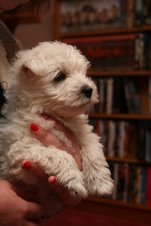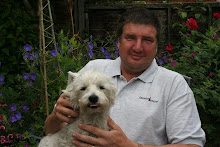
Another lovely day in our current run of warm ones, brings us to the end of June and day 28 for the Guinea Fowl keets. They are thriving and seem a very happy little group despite our decision that these would never get to go free-range. They are in a rabbit run at present but we are creating them an aviary between the 'Primrose Path' and the East Field. It will be roughly 30 feet long and a 6 foot by 6 foot rectangular 'tube'. You can see from the picture that they are getting their long necked, slightly stooped, adult shape but have so far not shown any sign of losing feathers from the parts of their face which will be bald and 'splashed' with vivid white and there are no signs of the bright red 'chilli pepper' wattles which their mother (Min the Hin!) has. They have a high, piping version of the adult 'buck-wheat buck-wheat' call and amuse us every evening with a joint chorus at bedtime. We have no idea what they are discussing (with hens it is traditionally meant to be Danish politics!). They group together and drift slowly towards the pop-hole calling continuously. Bizarre birds!

Also growing fast are the pigs, now 10 days off their 3-months birthday. They are well used to us by now and well familiarised with what time meals should be - if they see either of us walking about when they think they are due one, they are up at the fence, grunting and then starting to squeal to get our attention. I tried to get a pic today of their lying-on-your-back-getting-your-tummy-tickled thing but they were too interested in the food and too playful for lying down. Of course, after supper they strolled out into the grass by the orchard and stretched out in the sun, bellies exposed to the warmth, catching the rays - if only I'd have taken the camera.
 |
| Rolo sleeping in the strawberry patch. |
We did our weekly bee-inspection today. I was hoping that the colony would have expanded outwards from the original 6 'nucleus' frames across the remaining 6 of the brood box (3 either way) but we could not see sign of this. Maybe the frames were not all full, and the brood in them very young. Still, there is plenty of activity each day and we've seen plenty of pollen brought back to the hive (that is the protein to build little bee-larva bodies, so it is a sign that your queen is laying eggs each day). We will just have to be patient. We put the 'super' on anyway because we'd taken it down there with us. For those who know about these things we are not yet using the Queen excluder, so we are running the so called "Brood and a half" system. If the bees fill this, we will give them the 2nd super over the excluder, so that the top super will be just for honey. Mrs S (and little niece R) will be delighted to know that we used the smoker today properly and the bees were calm and relaxed - only a hundred or so came out to repel boarders - we were all done in about 10 minutes. Nobody got stung.

Meanwhile, Liz has diversified from the pure knitting into a bit of seamstress-ing. She is enjoying remembering her needlework classes from very young school days (so young that when you had a hem to make on a napkin, you had to get Mum to iron the creases into the hems). She has bought herself a very full kit of cottons, threads, needles, elastic and measuring tape as well as some nice fabrics. All the old saggy PJ's are suddenly as waist-hugging as new, many clothing items have been repaired for the little rips and tears from the barbed wire and I have seen an excellent fringe benefit in the work-shirt department.
 |
| Rhubarb and Ginger Jam |
When I was working in the UK I had amassed quite a collection of reasonable quality cotton shirts (Marks and Sparks was the 'tailor' of choice!) and for a lot of these, the only thing which went wrong was that the collars would go threadbare at the neck crease. Those would get 'audited out' and join the rag-bag. Not any more. Liz has found that they can be very neatly and professionally de-collared and go back into service over here where no-one is making rules about wearing a tie. I also have quite a few more 'posh' shirts for going out in - we bought Jaeger and Louis Copeland and neither of these got used for work or saw much use, so I am very much the snappy dressed pig-wrangler when I feel like it. It's not all 'grunge'. We are not quite 'Make do and mend' with the wartime ends-to-middle bed sheet fixes, but we do feel a bit green and recycling-orientated. Usefully, my beekeeper suit also got elastic thumb-loops on its sleeves today - they keep the sleeves pulled down nice and tight into the long gauntlet gloves. No gaps for the stinging marauders.
 |
| Snake's head fritillary seed pod |
So that's about it for June 2014. My final picture is of the snake's head fritillary seed pods now ripe and opening. These plants flowered back in Mid April, so you can immediately see why they can not survive in the wild in any commercially used grassland - grass in these parts is either grazed down hard by cattle, or it is zizzed off very short by the silage-mowers once in May/June and then again 10 or so weeks later. Plants like this simply do not have the time to flower, set seed and then ripen and shed it as they would have done in the more traditional July/August cut hay making regimes. In fact the silage boys got lucky this year and a lot of them saw good weather forecasts and left the grass which had been cut for silage on the ground, shook it through a couple of times with the hay-tedder and then baled it as hay. A lot of old, little-used equipment was getting greased up and dusted off. Fair play to them - make hay while the sun shines.








2 comments:
Hi Matt
Why do you put straw around the strawberries? Any ideas on Slug and snail control?
Regards Mark
Keeps the fruit up off the mud and stops them getting splashed with mud when it rains. Also, the pale colour of straw apparently reflects back plenty of sunshine to the underside of the fruit, encouraging ripening top and bottom. Slugs and snails we have always tried to control by just having a healthy organic ecosystem, where no one species takes over in the absence of predator/parasite species. In Kent we always had slug-free hostas near the pond, which had a good frog population.
Post a Comment